1992-2000 Lexus SC: More Than Just a Supra in a Fancy Suit
There are a few ways to look at the original Lexus SC. One is through the lens of brand history. The SC was Lexus’ second-ever model. If its original LS 400 was the smash-hit debut album, the SC was the also-excellent but definitely overshadowed follow-up. You could look at it, too, as the first Japanese luxury performance coupe to shake up a German-dominated segment, just as the LS 400 had done for the big fancy sedan market. You could also see it as an unfortunate dead end, as its 2001 replacement was a completely different—and a less-enthusiast-oriented—automobile.
Finally, you could consider its underpinnings, available 2JZ engine and five-speed manual, and decide it’s a dressed up, fancy Mk IV Toyota Supra at a (in today’s market) discount price. That was my thought process back in 2018 when I bought an SC 300 as a fun-ish daily driver. No matter how you approach it, though, the 1992-2000 Lexus SC is an interesting, very good and sometimes forgotten modern collector car that’s not exactly cheap, but definitely not expensive, either.
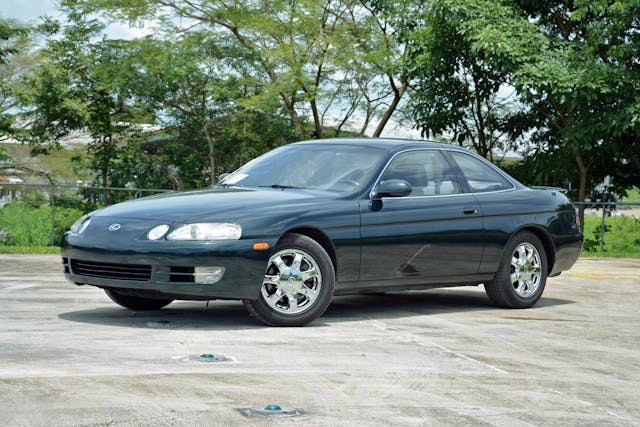

As the 1980s turned into the 1990s, anything and everything Japanese was still riding high, and the country’s economic bubble was still very much inflated. Toyota had introduced its Lexus luxury brand in 1989, and its debut model—the LS 400—was a Japanese executive sedan that was better, cleverer, cheaper, and ultimately more reliable than the European competition of the time. A natural next step was for Lexus to take the same philosophy and tackle the luxury coupe market. The result, introduced for the 1992 model year, was the SC (“Sport Coupe”).
Largely styled at Toyota’s Calty Design Research center in California, the SC abandoned the sharp edges of the previous two decades and foreshadowed the rounder edges of the ’90s. There are almost no straight lines anywhere in the SC’s body (“round as round can be,” Car and Driver called it) other than a character line running down the sides, and the shape is a fairly slippery one with a drag coefficient of 0.31. The designers started from scratch, working with plaster molds, scanning them, and digitally manipulating them with a computer. All advanced stuff 35 years ago, and the end product is undeniably handsome if not sexy. “Every inch of the Lexus coupe was designed to exhilarate you…even when you’re not moving,” said one commercial.
The inside was all proper luxury car fare, including leather, wood trim on the dash, cruise control, power windows and seats, and an optional 12-CD changer in the trunk. Long, heavy doors were made less ungainly by a novel hinge design that allowed them to swing both outward and forward (about three inches). ABS discs did the stopping. Power steering was standard.
A Toyota-badged version called the Soarer sold in Japan, while much of the SC’s platform was used for Toyota’s upcoming Supra. All were built at the company’s Motomachi factory.
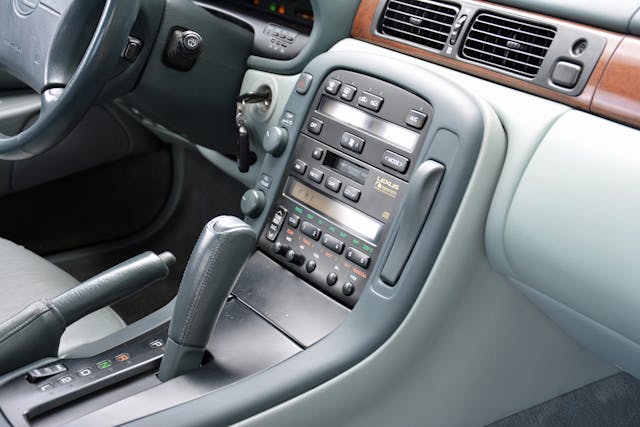

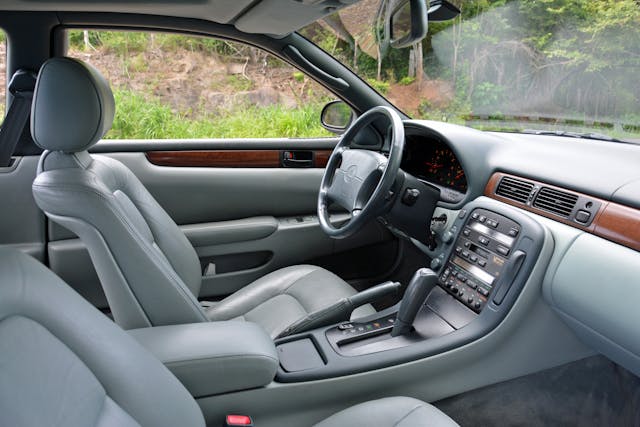
As for the drivetrain, SCs came in both six- and eight-cylinder flavors. But this wasn’t like choosing between a Z/28 and a base V-6 Camaro—for the Lexus buyers, selecting a six or an eight yielded a legend under the hood either way.
First introduced was the SC 400, which got the same famously robust 4.0-liter 1UZ-FE V-8 from the LS 400 sedan. Rated at 250 horsepower and mated to a four-speed automatic, it was enough to push the coupe to 60 in under seven seconds. Then, in the summer of 1992, Lexus introduced the SC 300, which got a version of the 3.0-liter 2JZ straight-six, the engine that became the darling of JDM lovers and tuners all over the world thanks to the Supra. Unlike Supra buyers, though, SC 300 buyers had no option for a twin-turbocharged 2JZ, and had to make do with a naturally aspirated version rated at 225hp and 210 lb-ft. Still, they had some consolation in that they could choose a five-speed manual, and stick-shift SC 300s could accelerate roughly as fast as the auto-only SC 400. When they came out, the SC 300 started at nearly $39K, and the SC 400 at nearly $43K.
While it didn’t get the same gushing reception as the LS when it debuted, the SC still got good press. Motor Trend gave the SC 400 Import Car of the Year for 1992, while Car and Driver concluded: “The SC400’s goal is to blow a hole through the blue-ribbon market for sports/luxury coupes…Can you say ‘bull’s-eye?'”

As the Lexus range expanded through the rest of the decade, the SC did receive some significant updates, though none resulted in dramatic change. For 1996, a redesigned front grille and bumper were added along with side skirts and rocker panels, while the SC 400 gained another 10 horsepower. New taillights and a modified spoiler were added in a mid-cycle refresh as well. For the 1998 model year, both engines got VVT-i (variable valve timing), boosting the SC 400 to 290hp. By the end of the decade, however, their designs were older and their price tags higher (a 1999 SC 400 started at $55K, over $100K in today’s dollars), while general interest in coupes was waning in America at the dawn of the SUV age. The second-generation SC, called the SC 430, was an all-new design with a hardtop convertible body and none of the sporting pretensions of its predecessor. It doesn’t have the same kind of following or respect in the enthusiast community as the original. In all, Lexus sold 82,538 first-gen SCs, split between 49,538 SC 400s and 33,000 SC 300s. Only 3883 people ticked the box for a five-speed.
The rarity of the manual transmission, and the prices at the time, were what attracted me to SC 300s almost exactly six years ago. A rear-drive coupe with a memorable engine, a stick shift, and a nice interior for way under ten grand? What’s not to like? One popped up that looked solid and drove well but was a little rough around the edges. When a car’s that rare you can’t be too picky, and I knew it was never going to be my forever car, so I bought it.
My Teal Mist Metallic SC turned out to be a great daily. In non-turbocharged form, the 2JZ delivers more of a smooth run of power and nice noise than anything urgent, but it’s plenty to have fun with. The ride is quiet and the car is softly sprung. The steering is a bit soft and noticeably boosted; it feels very ’90s in that regard. There is a surprising but manageable lack of headroom for a 6’2” driver, while the two back seats are small but decent enough for most passengers. Trunk space is surprisingly tight at 9.3 cubic feet.
It’s a solid GT car that’s fun when you want it to be, dignified the rest of the time, and that’s it. I liked that it wasn’t trying to be anything else. I liked this car a lot, but didn’t love it. When one too many things broke, I sold it on for about what I paid for it.

Today, survivorship is decent for the SC. The people who bought these cars new paid a lot for them (mine had a car phone, so you know the original owner was super-important) and because they’re Lexuses, after all, they tend to last a long time. But as ’90s Japanese coupes with rear-wheel drive and interchangeable Supra parts, plenty of SCs have been tuned and drifted.
And just because it’s a Lexus doesn’t mean it never has problems. SCs do have their quirks. SC 400s have their power steering pump mounted above the alternator, which will cause issues if the pump leaks. The hydraulically actuated fan on the SC 400 is also prone to failure, and aging original 1UZ engines are known to leak oil. The ECUs on both models can also suffer from leaking capacitors. These cars also get body rust, particularly around the rear wheel wells, above the windshield, and around the sunroof. Inside, the seats are prone to tearing and door panels get loose, while those clever door hinges wear out and result in a sagging, hard-to-open door. The digital screens are old LCDs and they can leak to become illegible, while lights in the gauge pods tend to dim and burn out. The regulators for the power windows are also a common failure, and a pain to fix. My SC had a couple of the above issues when I bought it. Eventually, it had all of them.

We don’t cover these cars in the Hagerty Price Guide, and the closest comparable car we do cover is the naturally aspirated version of the SC’s much more famous cousin—the Mk IV Toyota Supra. Depending on model year, those cars range from $22,900-$27,600 in #4 (“fair”) condition to $85,600-$91,400 in #1 (“best-in-the-world”) condition. One look at SC sales, however, and it’s clear that the Lexus comes much, much cheaper.
If you can find one, an excellent SC will set you back about as much as a rough, high-mileage non-turbo Supra. Since 2016, well over 100 SCs have sold on both Bring a Trailer and Cars & Bids, with the average price coming out to $14,500 for SC 300s and $13,200 for SC 400s. Later, rarer model years and particularly cars with VVT-i engines, tend to be more desirable. Clean, well-maintained, lower-mile SC 400s have sold for over 20 grand in a few instances. There does appear to be a five-speed premium for SC 300s, with a 17K-mile stick-shift car selling for $26,513 last December and a one-owner stick shift for $29,190 in 2021. Another one-owner five-speed car with 52K miles sold this year for $27,300. The most expensive example of either we’ve seen so far, though, is surprisingly an automatic SC 300 that was nevertheless exceptionally clean and sold for $32,550.
Although we don’t currently track values for SCs, we do insure them. Given that it’s a ’90s Japanese performance coupe, buyer interest for it skews surprisingly toward older enthusiasts, but then again this car was tailored to a more mature audience from the get-go. Insured values are mostly in the $11K-$12K range.
There aren’t any obvious signs of the SC market making drastic changes any time soon. Since it was something of a developmental dead end and didn’t make a huge cultural impact, it doesn’t have the same name recognition or enthusiast community as many of its contemporaries. It’s also not easy to find clean, unmodified examples. If you can, though, you’ll be rewarded with an enjoyable ’90s GT car for a fraction of what it cost new.
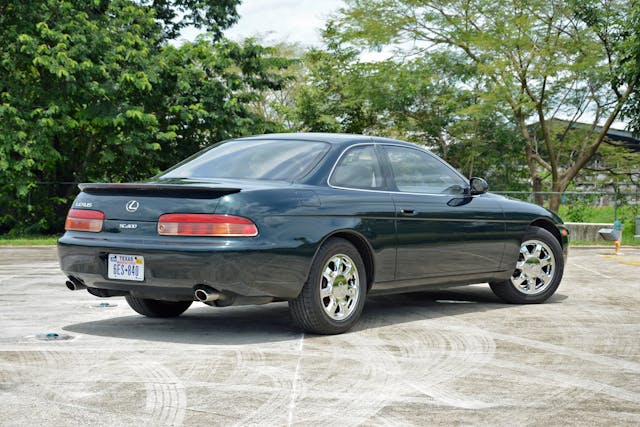
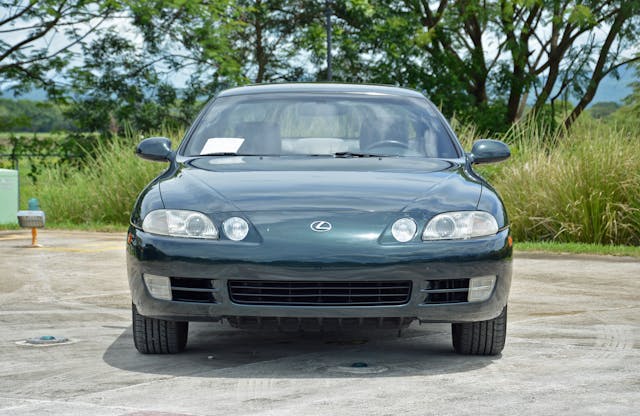


With fluid leaks and bad electronics it sounds like an old British sportscar only lacking any of the style and panache. It also lacks the acclaim of the SC 430 for being proclaimed by Top Gear as the worst car in the world. Whats a ‘fair’ condition Integra Type R going for?
These vehicles are basically 25 to 30+ years old. Electronics fail. Especially since most of these vehicles went from Luxury owners with regular maintenance to used cars for people wanting to have a luxury vehicle but can’t afford to have them maintained.
ps – Why plaster instead of clay? I’ve worked with both. You can rework clay, plaster, work fast and start over if you get it wrong. No time to contemplate. Doesn’t sound like the most efficient way to design a car.
I forgot how plain looking these are.
I like these alot. Very reliable, comfortable luxury, decent performance. Not a bad looking car at all, IMO.
These cars were never a secret. Back in the 90’s and early 00’s these cars were wanted for their ease in which they could be turned into a Supra with luxury. I remember a friend with one of these modified to make 850hp at the wheels back in 2004 if I remember the year correctly. Those into the JDM scene will often badge them as Toyota Soarers or leave the Lexus badge to put the car next to them into a false sense of security before they blew them away. If you wanted to go Turbo, you likely got an SC300 and either boosted the factory 2JZ-GE or you motor swapped to a turbo 2JZ-GTE motor and built it out. Some would motor swap an SC400 or maybe do forced induction but the majority would motor swap if they wanted the luxury Supra route. Personally I would love to see the 2UR-GSE motor from the LC 500 / IS 500 / RC F / GS F in one of these cars with the 8 or 10 speed auto from today. That would be a perfect luxury sleeper.
I had a ’95 SC300 in Royal Jade green (the dark green in most of this article’s photos) that I leased new. Your article hit on most of the annoyances – tiny trunk, lack of headroom – that I experienced. Since the car was new and I only kept it for 3 years, I did not experience any of the long term wear points mentioned in the article.
When I got mine, stick shifts were not to be found anywhere. I would imagine that finding one with a stick today would be even more of a challenge. I also disagree with the article in that with mine, the ride and steering were pretty taut – especially compared with other Lexus models (I had a LS400 right before the SC). “This is a Lexus that handles…” was a description I frequently used to describe the car to colleagues. I guess the suspension gets tired with age like those elaborate door hinges.
It was a very stylish car of the era and I always got complements but because of the cramped interior I was not sad to see it go when the lease was up. The late 90s was the beginning of the end of the malaise era and better cars were coming to market.
“Just a Supra”? Sounds a bit demeaning of the car that is hundreds of times more sought after than the SC.
As I ’97 Supra Turbo Owner and fan of the Lexus SC I see nothing offensive in the title of an article. The writers intent seems to be just fine.
I have owned 2 SC300’s and loved them both. They are the perfect blend of sporty luxury and reliability that is equaled by none! I am surprised at the comment of lack of trunk space as I can easily get 2 full sets of golf clubs in with ease. While off the line acceleration is nothing great, when the rpm’s get up to 4000+, the motor sounds great and will easily climb to 140+ mph! I currently have an unmodded ’98 with 60k miles and hope to keep it forever!
Bought a SC400 three or four years ago for the engine. The transmission was on its last legs, but the car ran great, accelerated well, handled well, and the engine was smoke-free. Had the typical electric issues (dash illumination weirdness, HVAC backlighting was out), but so what. Sold the trans for $100. Sold the car shell to a guy who wanted the front subframe for a swap into a vintage Ford Ranger (claimed the frame rails are the same width and distance apart as the SC). So netted out a strong 1UZ for only $1100. If I had more space, I probably could have parted it out and saved even more. But the Mrs. wanted the “smelly car” out of the driveway.
The door hinges were a pretty cool engineering feature – especially useful since the door sills were so wide.